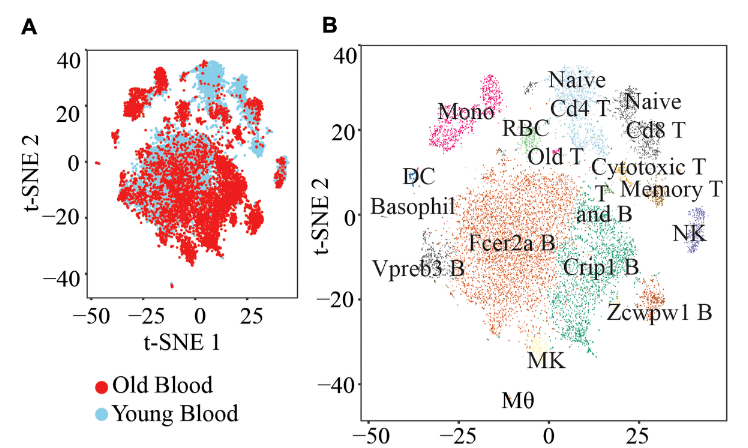“Here, we profiled 14588 single cells from the mouse blood and assessed the differences between young and old mice.”
BUFFALO, NY- January 16, 2023 – A new research paper was published on the cover of Aging (listed as “Aging (Albany NY)” by Medline/PubMed and “Aging-US” by Web of Science) Volume 15, Issue 1, entitled, “Single-cell transcriptomics of peripheral blood in the aging mouse.”
Compositional and transcriptional changes in the hematopoietic system have been used as biomarkers of immunosenescence and aging. In this new study, researchers Yee Voan Teo, Samuel J. Hinthorn, Ashley E. Webb, and Nicola Neretti from Brown University used single-cell RNA-sequencing to study the aging peripheral blood in mice and characterize the changes in cell-type composition and transcriptional profiles associated with age.
“The functional decline of the immune system with age, or immunosenescence, is associated with different hematopoietic changes, including a decrease in the replication ability of hematopoietic stem cells and B lymphopoiesis, and lower efficiency in CD4 and CD8 T cells response [1].”
The team identified 17 clusters from a total of 14,588 single cells. They detected a general upregulation of antigen processing and presentation and chemokine signaling pathways and a downregulation of genes involved in ribosome pathways with age. In old peripheral blood, the researchers also observed an increased percentage of cells expressing senescence markers (Cdkn1a, and Cdkn2a). In addition, a cluster of activated T cells exclusively found in old blood was detected, with lower expression of Cd28 and higher expression of Bcl2 and Cdkn2a, suggesting that the cells are senescent and resistant to apoptosis.
“Finally, targeting senescent cells using genetic approaches has been shown to ameliorate the aging phenotype [34, 35]. More recently, senolytics drugs are being identified or developed to target apoptotic pathways because senescent cells are known to be apoptosis-resistant [34]. Therefore, the Bcl2+ old T cells that we identified in old mice can potentially be targeted pharmacologically to ameliorate the phenotypes associated with the aging of the immune system.”
DOI: https://doi.org/10.18632/aging.204471
Corresponding Author: Nicola Neretti – [email protected]
Keywords: aging, single-cell transcriptomics, senescence, peripheral blood
Sign up for free Altmetric alerts about this article: https://aging.altmetric.com/details/email_updates?id=10.18632%2Faging.204471
AGING (AGING-US) VIDEOS: YouTube | LabTube | Aging-US.com
About Aging-US:
Launched in 2009, Aging (Aging-US) publishes papers of general interest and biological significance in all fields of aging research and age-related diseases, including cancer—and now, with a special focus on COVID-19 vulnerability as an age-dependent syndrome. Topics in Aging go beyond traditional gerontology, including, but not limited to, cellular and molecular biology, human age-related diseases, pathology in model organisms, signal transduction pathways (e.g., p53, sirtuins, and PI-3K/AKT/mTOR, among others), and approaches to modulating these signaling pathways.
Please visit our website at www.Aging-US.com and connect with us:
- SoundCloud – https://soundcloud.com/Aging-Us
- Facebook – https://www.facebook.com/AgingUS/
- Twitter – https://twitter.com/AgingJrnl
- Instagram – https://www.instagram.com/agingjrnl/
- YouTube – https://www.youtube.com/agingus
- LinkedIn – https://www.linkedin.com/company/aging/
- Reddit – https://www.reddit.com/user/AgingUS
- Pinterest – https://www.pinterest.com/AgingUS/
For media inquiries, please contact [email protected].
